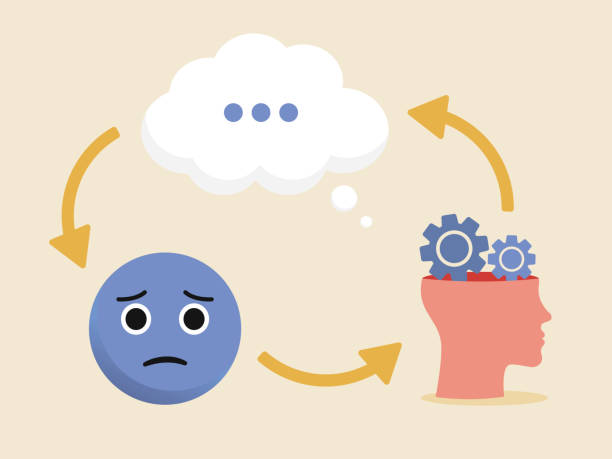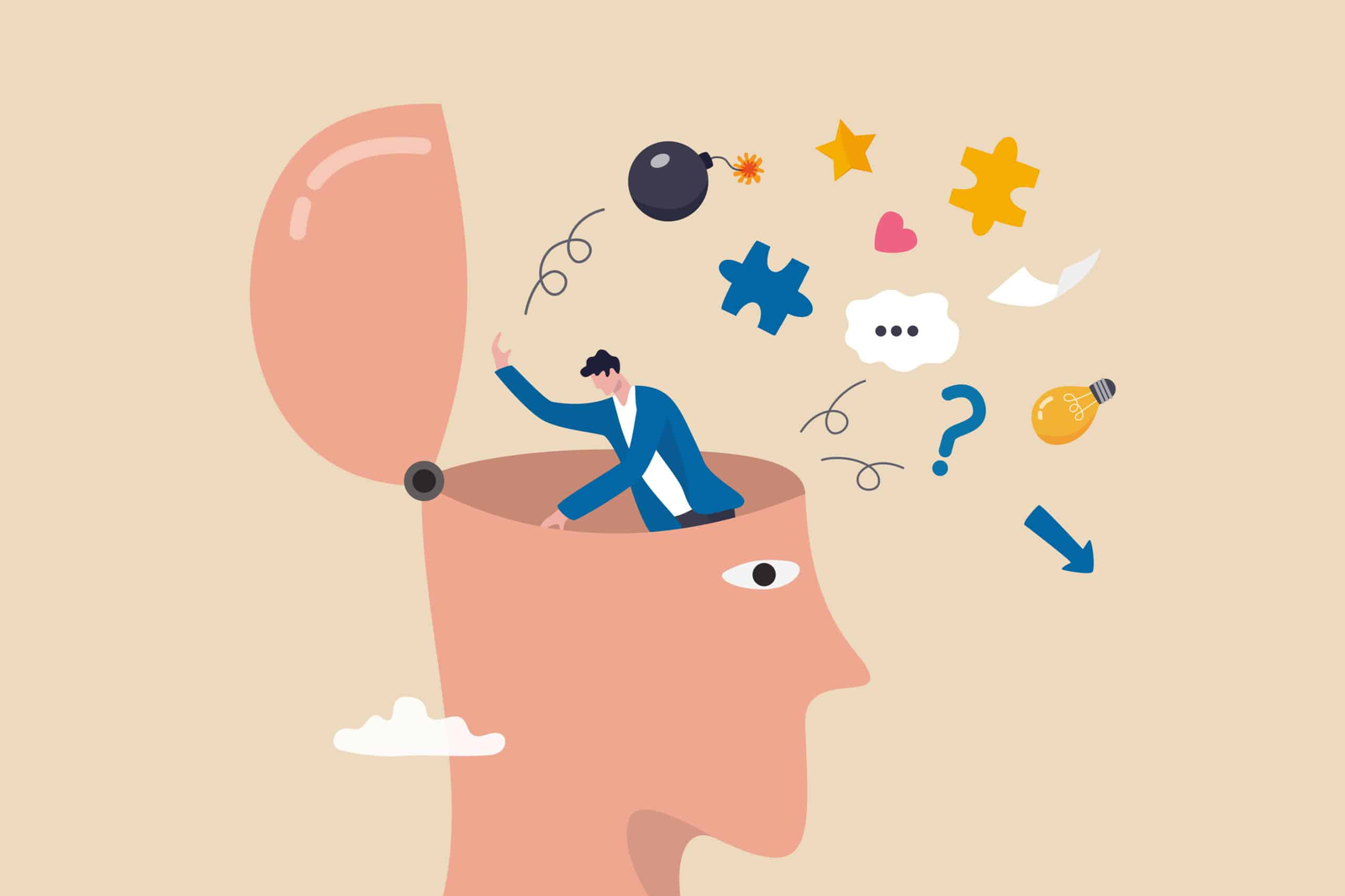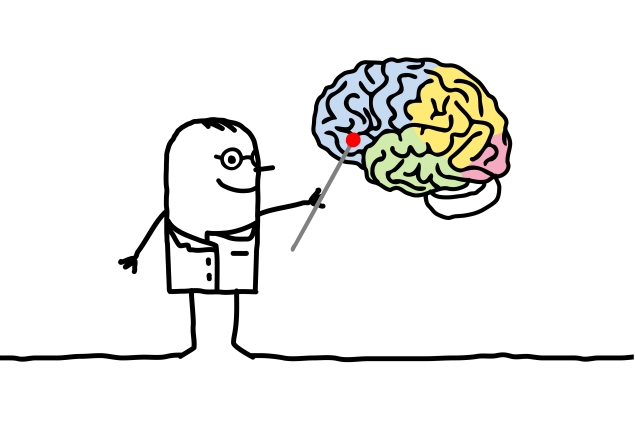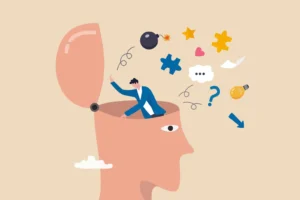
In an era where intrusive thoughts and overthinking seem to plague many, the ability to detach from one’s own mind can be transformative. This is where cognitive defusion, a technique from Acceptance and Commitment Therapy (ACT), becomes a powerful tool. Cognitive defusion enables individuals to create mental space between themselves and their thoughts, leading to greater clarity, reduced stress, and improved mental well-being.
Cognitive defusion delves deep into how we can manage our relationship with thoughts, especially the negative ones that hold us back. The idea is simple but powerful: thoughts are not facts, nor are they definitive truths about who we are. They’re simply mental events, fleeting and often irrational. By learning to observe these thoughts without getting entangled, we can make better decisions and pursue actions that align with our values.
The Concept of Cognitive Defusion

Cognitive defusion helps people step back and recognize that they don’t have to believe or act on every thought that crosses their mind. Instead, they can choose to observe their thoughts, assess their relevance, and decide whether or not they’re worth paying attention to. The key lies in developing a mental toolkit that includes practical skills like mindfulness and cognitive defusion, which encourage a non-judgmental awareness of one’s internal dialogue.
Key Takeaways on Cognitive Defusion:
- Distancing from Thoughts: Cognitive defusion is about creating a buffer between yourself and your thoughts, so you’re no longer at the mercy of unhelpful beliefs.
- Recognizing Thoughts as Thoughts: By identifying thoughts as “just thoughts,” people can avoid the tendency to view them as facts or as statements about their identity.
- Embracing Acceptance: Rather than fighting or suppressing negative thoughts, the goal is to let them be, allowing them to pass naturally.
- Questioning Helpfulness: An essential part of cognitive defusion is asking whether a thought serves your goals and values. If not, it can be observed and then released.
- Reframing Language: Instead of saying, “I am a failure,” cognitive defusion encourages you to reframe this as “I’m having the thought that I am a failure,” making it easier to recognize the thought’s impermanence.
Cognitive Defusion vs. Cognitive Distortion

While both cognitive defusion and challenging cognitive distortions aim to improve mental well-being, they differ in their approaches. Cognitive distortions involve identifying and correcting irrational thoughts—like all-or-nothing thinking or catastrophizing. In contrast, cognitive defusion encourages stepping back and observing thoughts without judgment. Instead of actively disputing every negative thought, individuals learn to see thoughts as temporary and often untrustworthy narratives.
Examples of Cognitive Defusion in Action:
- Naming Your Thoughts: Labeling a thought (“This is a worry thought”) helps put it into perspective, preventing you from reacting emotionally.
- Using Humor: Repeating negative thoughts in a silly voice or out loud can strip them of their power and make them less intimidating.
- Symbolic Release: Writing down distressing thoughts and physically letting them go, such as by throwing the paper away, can provide a sense of release.
Building an Emotional Toolbelt

One of the most valuable messages from the video is the idea of an “emotional toolbelt”—a set of skills you can call upon when faced with challenging thoughts or emotions. By adding cognitive defusion to your repertoire, you’re equipping yourself with a strategy that prevents you from becoming consumed by negativity.
Developing a diverse set of emotional skills is crucial, especially when tackling mental health issues such as anxiety or depression. Mindfulness, for example, promotes awareness of your thoughts without immediate reaction. Combined with cognitive defusion, these practices provide a holistic approach to emotional well-being.
Examples of Emotional Tools:
- Mindfulness: Paying close attention to the present moment without judgment.
- Values Identification: Defining what truly matters to you and letting that guide your actions.
- Acceptance Practices: Allowing emotions to exist without feeling the need to change or suppress them.
Practical Steps for Cognitive Defusion

- Observe Without Judgment: Instead of analyzing or judging thoughts, simply observe them as mental events.
- Ask About Helpfulness: Evaluate if a thought is beneficial. Does it align with your values? If not, let it pass.
- Reframe Negativity: Turn statements like “I’m not good enough” into “I’m having the thought that I’m not good enough,” creating distance.
- Practice Regularly: Building cognitive defusion skills takes time, so engage with ACT resources and practice routinely.
- Set Your Focus on Values: Redirect attention to activities and decisions that support your core values, as opposed to becoming distracted by fleeting thoughts.
Highlights
- Thoughts are Not Facts: The biggest shift cognitive defusion offers is realizing that thoughts are not absolute truths.
- Flexible Emotional Responses: Having a range of responses to emotions allows for better coping and decision-making.
- Engaging with Thoughts Mindfully: Avoid becoming obsessed with thoughts; instead, practice noticing and letting them pass.
- Empowering Acceptance: Acceptance, rather than resistance, can reduce the hold negative thoughts have on you.
- Reaffirming Self-Value: Staying grounded in your values gives purpose to your actions, independent of fleeting worries or doubts.
Benefits of Cognitive Defusion for Emotional Health

In the context of emotional well-being, cognitive defusion encourages individuals to adopt a more flexible mental approach. This flexibility allows them to acknowledge their inner experiences without letting those experiences control their lives. As the speaker explains, people often get trapped by cognitive fusion—becoming so entangled with their thoughts that they mistake these thoughts for reality. Cognitive defusion offers a way out, empowering people to view their thoughts objectively.
When applied regularly, cognitive defusion can lead to a healthier mental state. Rather than constantly battling thoughts, individuals learn to recognize them as temporary and not necessarily representative of reality. This approach promotes resilience, reducing the emotional impact of negative thoughts.
Key Highlights of the Approach:
- Distinguishing Thoughts from Reality: Cognitive defusion helps individuals understand that thoughts don’t define their identity or reality.
- Focusing on Actions Over Emotions: Instead of fixating on unhelpful thoughts, individuals can engage in behaviors that align with their values.
- Holistic Mental Health Improvement: Integrating cognitive defusion with other mental health practices provides a well-rounded approach to managing emotions.
Learning and Applying Cognitive Defusion
The speaker encourages viewers to explore additional resources within Acceptance and Commitment Therapy (ACT) to fully grasp cognitive defusion’s potential. As a skill that can support resilience and well-being, cognitive defusion complements other therapeutic techniques, enhancing emotional flexibility. The speaker also mentions an emotional skills course, emphasizing that processing emotions is essential for managing depression, anxiety, and other mental health issues.
Additional Suggestions for Emotional Processing:
- Regular Mindfulness Practice: Mindfulness helps keep thoughts in perspective, promoting a state of calm and awareness.
- ACT Resources: Books, videos, and workshops on ACT can provide practical exercises to develop cognitive defusion.
- Engagement with Community: Sharing insights and learning with others fosters accountability and helps individuals remain consistent in their mental health journey.
Final Thoughts
Cognitive defusion is a game-changing tool that equips individuals to handle intrusive thoughts and overthinking in a healthier, more constructive way. By learning to observe thoughts without judgment and assessing their helpfulness, cognitive defusion allows individuals to shift their focus from self-defeating patterns to value-driven actions. This shift empowers them to navigate their emotions more effectively and to live in a way that aligns with their deepest principles.
The journey of managing one’s mental health isn’t always straightforward, but developing a toolkit that includes cognitive defusion can make a significant difference. The real power lies in choosing which thoughts deserve our attention and which can be let go, a skill that contributes to a healthier, more fulfilling life.















